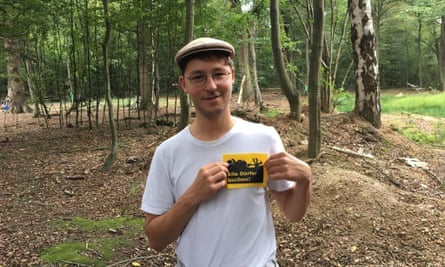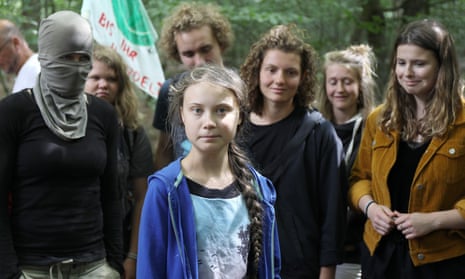Greta Thunberg started her long journey to climate summits in the Americas by joining a treetop protest in Germany’s Hambach forest, where environmentalists have been fighting for years to stop the ancient woodland being torn up for open-cast coal mining.
The battle to save the last remaining oak and hornbeam trees reflects the young activist’s entwined fights to protect the natural world from human exploitation and to halt carbon emissions.
“The Hambach Forest is so important because it’s so symbolic,” Thunberg told the Observer, standing under treehouses where activists live year-round to stop the trees being felled. “[The mining here] is such a huge contribution to the ecological crisis and the climate crisis.”
Earlier the 16-year-old Swede – who is about to set sail for the US and Chile to attend UN climate summits – had visited the mine, an open wasteland that stretches for kilometres, taking in both former forest and former farmland. She met people from the surrounding area whose villages are also due to be razed to make way for the mine.
“I have visited coal mines before, but this was so huge and so devastating to see,” she said. “It makes me incredibly sad, to see all this destruction, in this area that used to be a forest ecosystem, and I feel sorry for the people who have to move.”
The area, near Cologne in western Germany, is home to endangered species, including Bechstein’s bats, but its trees and fern-filled clearings also represent a rare remaining sliver of a woodland ecosystem that once filled this part of the Rhine river plain.
Since mining began in 1978 the Hambach – or Hambi as activists affectionately call it – has shrunk to only 10% of the original 13,500 acres. The rest was cleared to allow the utility firm RWE to extract the “brown coal” or lignite lying beneath, at a rate of about 40m tonnes a year.
The trees are felled and the forest floor torn up to reach coal deposits, leaving long gashes of open earth, that mark out the mine on satellite photographs with streaks of black and ochre. The lignite, along with supplies taken from other mines in the area, is burned in nearby power stations. Three, the Niederaußem, Neurath and Weisweiler plants, are all individually among the 10 biggest carbon dioxide emitters in Europe. Together they make the region’s coal the continent’s biggest source of the greenhouse gas, the activists say.
For more than seven years a committed group have been living in some of the oldest, tallest trees, serving as human shields against RWE.
When Thunberg won Germany’s Golden Camera award in March, she dedicated it to the Hambach activists, who invited her to come and see their struggle for herself, and she started her trip to the Americas by taking up that offer.
After visiting the mine she joined activists in one of the highest protest sites, lifted 15 metres off the ground in a climbing harness to a wooden house in the high branches of a centuries-old oak tree.
Jana Boltersdorf, a 17-year-old protester who has been coming to the forest for years, said Thunberg’s visit was a “surreal” inspiration.
“She has become a great symbol for climate justice, and this forest also has become a great symbol for climate justice,” Boltersdorf said. “Now those two great symbols which are very important to my life are coming together. It doesn’t feel real.”
Several times the treehouses have all been cleared and their occupants arrested, and several times the activists have returned to their perches. But in 2018, the regular showdown captured national attention, said Luisa Neubauer, one of the leaders of the Fridays for Future youth movement in Germany.

And when it reached the national stage, the battle for Hambach brought the climate crisis into focus for many Germans, she believes, by connecting intangible carbon emissions to something both tangible and much loved.
“Wild forest in Germany is a very important part of our culture, of our understanding of what this country is,” Neubauer, said. “It’s impossible [for many people] to imagine protecting the climate, but it is possible to imagine protecting the forest.”
Its destruction seems shortsighted as Germany pivots away from coal, which still provides about a third of the country’s electricity. With a target to cut greenhouse gas emissions by 40% compared with 1990 levels, by next year, Berlin needs to act urgently.
A government-appointed commission said last month that Germany should shut down all of its coal-fired power plants by 2038, and recommended setting aside €40bn (£37bn) in aid to help areas affected by the shutdowns, where the mining and power industries are major employers.
That new deadline has brought both frustration and hope for the forest protesters and people in villages around the area, whose homes had been slated for destruction.
David Dresen, 28, has given up his job as a maths teacher to campaign for Kuckum, the village where his family have lived in the same farmhouse since the 1700s. Along with six others in the area it is due to be destroyed in 2027, but what once seemed like an almost hopeless fight now feels less bleak.
“We have been fighting lignite since the 1980s and for a long time no one heard what we said,” he said after meeting Thunberg. “If this movement is able to save the forest, why should it not be possible to save our villages?”
What remains of the forest has been given a stay of execution, but this is only temporary. With the confrontations between protesters and police gaining widespread publicity, and a case brought by environmentalists making its way through the courts, RWE has agreed a moratorium until 2020.
Thunberg will be attending climate summits in New York in September and Santiago in December. She does not fly because of the carbon footprint this leaves, and so will travel overland to the UK, cross the Atlantic on a racing yacht, and finally travel by train and bus to Chile. “I have not sailed before, so I’m going now to get some basic lessons on what to do and what not to do,” she said. “But the people I’m going with are professionals so I’m not worried about safety.”
